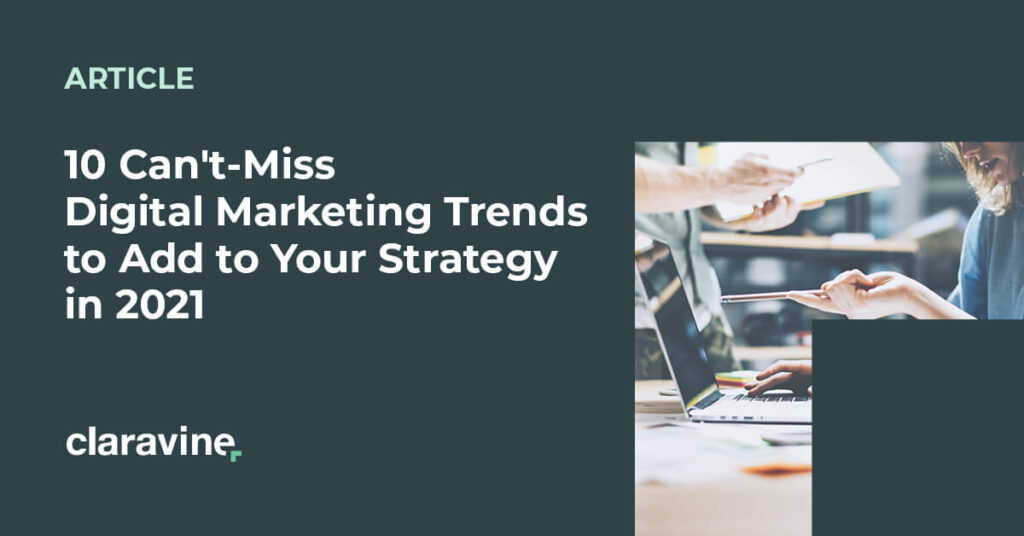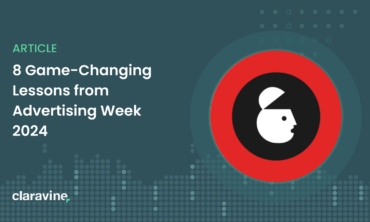10 Can’t-Miss Digital Marketing Trends and Tactics You Need to Add to Your Strategy in 2021

Have you ever thought to yourself, “how can I improve my digital marketing strategy?” Hopefully, you’re nodding your head. In some way, shape, or form, you should come into a new year ready to reevaluate and optimize your strategy. A decade ago, that may have meant dipping your toes into the blooming social advertising ecosystem. Today, digital marketing trends and tactics, like data governance, artificial intelligence as well as augmented reality, are powerful ways for you to break through the online world’s noise; you’d be wise to take note of emerging trends and tactics and add them to your strategy. In 2021, it’s your job to find exciting new ways to delight consumers. Here are ten ways you can do that:
Data Governance
Data isn’t new. For years, you’ve relied on it to craft effective digital marketing strategies. This won’t change. What will change is the volume and complexity of the data available. This surge—primarily created by the uptick in online usage during the COVID-19 pandemic—will force you to evolve your data practices. Not only will you likely have to up your investment in the infrastructure to support the increased volume, but you’ll also have to train your teams to handle it. More data is only a good thing if you know how to handle it and make the most of it.
Artificial Intelligence
It’s unrealistic to expect anyone to keep pace with the digital marketing world by themself. Between social (including up-and-coming ones like TikTok), digital display, and exciting new advertising ecosystems like connected TV (CTV), it’s a foregone conclusion that you’ll need to use third-party technology to help juggle everything. This is why artificial intelligence will be so important. While there’s an endless list of ways you can apply AI, implementing AI-driven data controls that take over the mundane but necessary tactics of a successful digital marketing strategy can be a relatively light lift that has the potential to boost ROI.
Augmented Reality
When Mark Zuckerberg bets on augmented reality as the company’s next big thing, it’s time to take note. Sure, augmented reality in the advertising world is still relatively new, but that shouldn’t stop you from experimenting. Some of the world’s biggest brands are already seeing success. For example, Home Depot is giving consumers the ability to “test” paint colors with its mobile app. Similarly, Sephora’s customers can see how makeup products look on their faces before they buy. However it’s done, augmented reality can give you an unprecedented way to capture consumer attention—and keep it, which is why spending on AR continues to rise.
Conversational Marketing
Conversational Marketing taps into the power of real-time conversation to move buyers through the marketing and sales funnels. A task that has historically been riddled with tedious, time-consuming, and sometimes intrusive forms, Conversational Marketing opens the door for you to communicate with consumers and collect vital information in a human way. Having this ability will be a saving grace as consumers grow tired of jumping through hoops to interact with brands.
Social Commerce
Social commerce has been a pipedream for a long time. No matter how effective Facebook or Instagram ads have been at driving brand awareness and consideration, they’ve always lacked one thing: the ability to drive sales. Well, that’s changing, and changing fast. Today, most of the major social players, including Facebook, Instagram, and Snapchat, have invested in social commerce. For instance, Snapchat ramped up its shopability when it unveiled Lens-enhanced “shoefies” that allow users to digitally “try on” shoes and shop them. The introduction of Facebook Shops and Instagram Shopping is also indicative of the increased focus on social commerce.
Personalization
Consumers have made it clear that they’re tired of intrusive ads. In fact, according to The CMO Survey, 3 out of 4 users think there are too many of them. Why? Because most of the time, they don’t add value. As a result, if you continue to cast a wide net, you’ll be putting yourself in a precarious situation and risk ruffling consumers’ feathers. This is why advertising personalization will be so important. Moving forward, you must create personal connections with consumers through different communications platforms and make them feel like the ad they’re seeing was made for them and not hundreds or thousands of people who may have something in common with them, like age or occupation.
First-Party Data Strategies
With the introduction of CCPA and GDPR—both of which regulate how businesses can collect and use consumers’ data—it’s becoming clear that consumers are serious about their privacy online. In turn, it’ll become paramount that you identify different digital marketing strategies and tactics that remain effective without crossing the line. One way to do that is by implementing a first-party data strategy, which taps into opted-in data instead of data collected without a user’s consent.
Influencer Marketing
Influencer marketing has been around for years. Nevertheless, it continues to gain steam thanks to its ability to foster authentic connections between the brand and its customers. Influencers use social media to connect with the audience by creating content in the form of pictures, posts, engaging videos, etc. They bridge the gap between brands and their audience by building trust and marketing their products.
Think about it: If you’re in the market for a product or service, who will you trust more? The company’s CEO or someone just like you? More times than not, you’re going to value the advice and “influence” of someone you can relate to. This is why influencer marketing will continue to be such a powerful tool and why ad spend on influencers continues to rise.
Video Ads
According to Statista, spending on digital video ads is expected to eclipse $22 billion in 2021—a 69% increase in less than a decade. On the one hand, this is good; it means video works. On the other hand, however, it means that there’s a lot of competition. Luckily, there’s an array of video ad options for you to choose from, including in-stream, CTV and OTT, and mobile video, which all give you the ability to create engaging advertising experiences that drive ROI.
Voice Ads
Voice ads are a relative newcomer to the advertising scene, but that doesn’t mean you should shy away from them. Defined as a “voice-enabled audio ad that prompts the consumer to engage directly with the advertisement using their own voice,” voice ads are quickly gaining steam due1 to their ability to create “conversations” with consumers. Pandora and Spotify, the two most prominent names in audio streaming, have introduced voice-enabled ads, effectively launching them into the market.
Conclusion: Digital Marketing Trends and Tactics are Worth Your Consideration
Nascent digital marketing trends and tactics can be intimidating. A lot of times, they’re early in their evolution and unvalidated. As a result, it can be intimidating to allocate any portion of your ad budget to them. As a marketer in a digital-first world, I get it, but it’s your responsibility to do whatever it takes to connect with consumers in meaningful ways. Sometimes, that means stepping outside of your comfort zone and experimenting with trends and other up-and-coming tactics like conversational marketing, voice ads, and influencer marketing. While it can be scary, most of the time, it’s worth a try. Remember, a decade ago, digital marketers were reluctant about Facebook ads, and look where we are now. Who’s to say that any of these ten trends and tactics won’t go mainstream, too?



